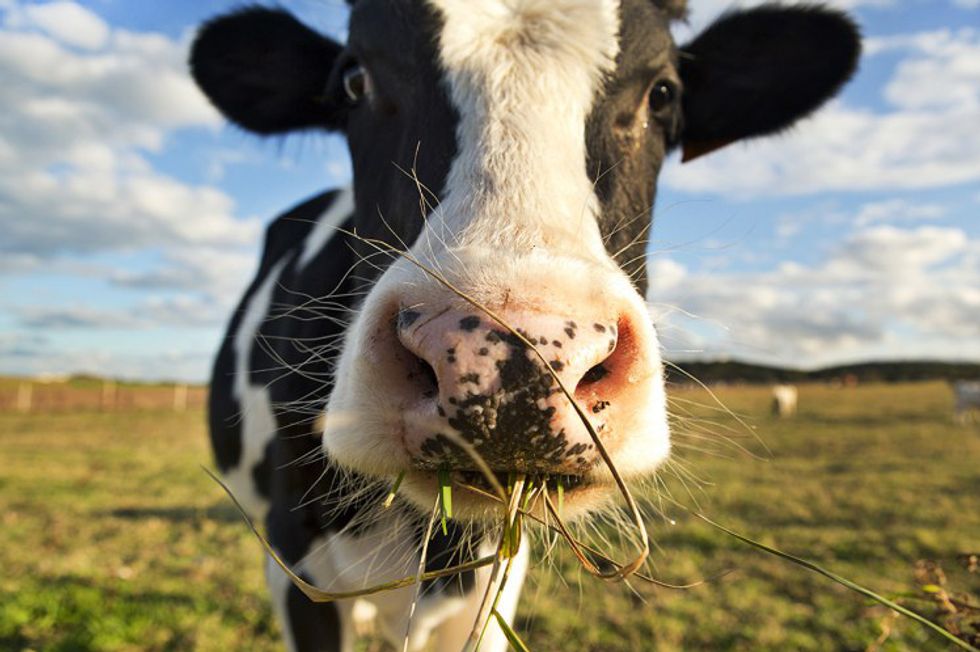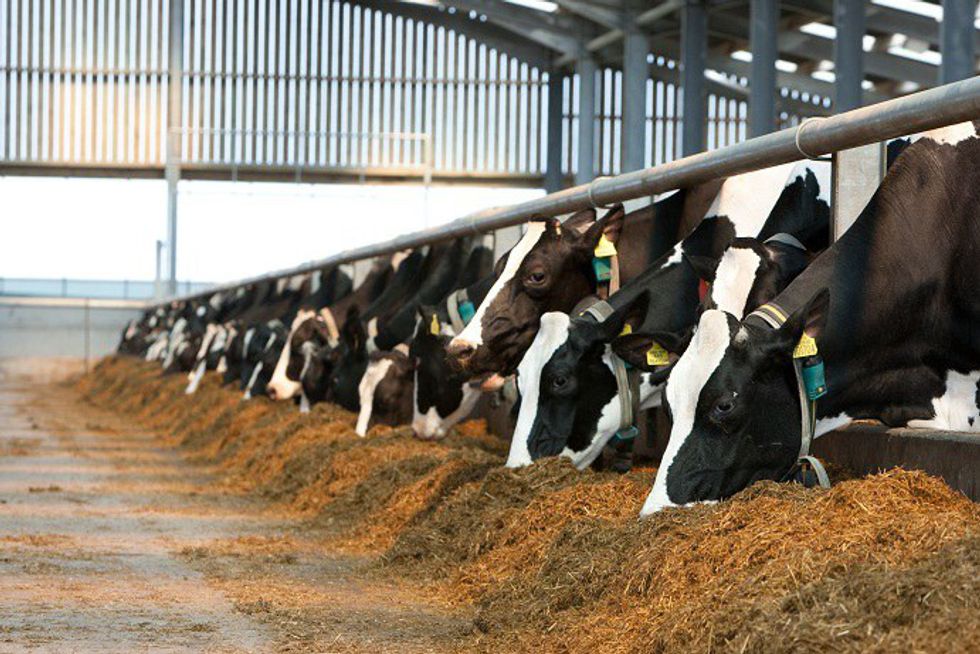A usual day for a dairy farmer starts around 4 a.m. They get up, milk cows, feed cows, feed themselves and then do it again a few hours later. Dairy farmers have dedicated their lives and families to ensuring that each of us have milk in the fridge, and food on the table. They work 365 days a year, they do not get a weeks vacation, they do not get to open presents on Christmas until the cows are milked. I may not have grown up on a farm, but working on a farm has given me values and memories I will cling to for the rest of my life. I am proud to be a part of American agriculture and the dairy industry, and so is every farmer across the country.
Here are some things we would like you to know about the industry we fell in love with from the start:
1. According to Midwest Dairy, there are about 47,000 dairy farms in the United States. 97 percent of these dairy farms are family owned and operated.
The Groetsch Dairy Farm has been family owned since 1929. Steve and Lisa bought the farm from Steve's parents in 1989, and it has been growing ever since. They have updated multiple barns and equipment in order to expand their herd and to tend to the cows better. They started with 47 cows in 1989, and now they have expanded their herd to over 290 milking cows along with 250 heifers and steers. Thank you to all the dairy farmers that get up at ungodly hours day in and day out to provide consumers with wholesome milk that provides essential nutrients.
2. Most milk is consumed within a few miles of where it is produced.
It only takes 48 hours for milk to travel from the farm to the store. A huge milk truck comes and picks up the milk, then takes it to the processing plant. There it is pasteurized, which is heating up the milk above 160 degrees or higher for 15 seconds, and then rapidly cooling it to kill unwanted bacteria, keeping the milk safe and wholesome. It is also homogenized, which makes all the fat distribute evenly. This is why we do not have to shake milk cartons anymore. Then it is packaged and sent to grocery stores. Lastly, the consumers enjoys a cool glass of milk less than 48 hours after it was produced less than 100 miles away.
3. The two things that dairy farmers care the most about is their animals and the land.
Farmers take extra precautions to make sure that they keep the soil healthy and to prevent erosion. To a farmer, everyday is Earth Day because protecting the environment is an everyday task. Also, farmers take very good care of their animals because they are their livelihood. Cows are kept comfortable by having different types of bedding, ranging from sand to rubber mattresses. Barns are equipped with many large fans and sprinklers to keep cows cool in the summer. They even have rotating scratching posts for cows to get a nice back scratch. If that doesn't look like a happy cow, I am not sure what does.
4. According to the USDA, The United States dairy industry contributes less than 2 percent of the total "greenhouse gases" into the environment.
Dairy farmers are working with the World Wildlife Fund in order to reduce the amount of greenhouse gases going into the environment. Over the past six decades, we have reduced our carbon footprint by over 60%. Farmers across the United States use the manure from cattle to produce renewable energy. Dairy farmers are constantly trying to make agriculture more sustainable while feeding the increasing population. If you are interested in finding out more, check out these outstanding sustainable dairy farms.
5. 75 percent of a cows diet can not be consumed by humans.
Cows are ruminants, which means that they have four compartments to their stomachs. Because they are ruminants, they are able to digest parts of plants that humans are unable to. Cows are fed a combination of forage, like hay or corn silage, grains (corn, wheat and barley) and protein sources, such as soybean meal, plus vitamins and minerals. Farmers mix the feed every single day before feeding in order to ensure the cows get the proper amounts of each part of the feed. Farmers work closely with nutritionists to ensure that they cows are getting the best feed with the most nutrients. Cows consume about 100 pounds of feed a day, and also drink 30-50 gallons of water a day.
6. Calves represent the future.
Dairy farmers take very special care of their calves because they are the future of the farm. When a cow is close to giving birth, they are taken to a maternity pen to have extra comfort, and to be monitored closely. Shortly after birth, calves are moved to calf hutches or pens. This protects them from getting sick from the environment and other animals because they have to let their immune systems mature. These calf hutches allow for specialized feeding and close monitoring.
7. A single dairy cow will produce six to eight gallons of milk a day.
Cows are milked two to three times a day depending on what farm they are on. It only take five to seven minutes for a cow to be milked. Each cow produces about 90 glasses of milk a day! We wash our cows very well before milking to ensure the best care for our cow, but also the best milk for the consumer. We clean the udder, using a dip that cleans the tit, but also kills any bacteria that could get into the udder while milking. After drying the teat, we strip each quarter to check for any abnormalities in the milk, then we attach the milking machine. After they are done, the machine is removed and the dip is applied again to protect the teats after milking.
8. There are seven different breeds of dairy cows in the United States.
The seven different breeds of dairy cows in the United States are Holstein, Jersey, Brown Swiss, Guernsey, Ayrshire, Milking Shorthorn and Red and White Holstein. The most common dairy cow is the Holstein. They are the most common because they produce the most milk compared to any other breed. They are known for their black and white markings. Holstein cows originated in the Netherlands and were brought to America in 1621.
9. Dairy products provide nine essential nutrients.
The nine nutrients milk contain are calcium, potassium, phosphorus, protein, vitamins A, D and B12, riboflavin and niacin. Eating and drinking dairy products is important because it improves your bone strength, lowers blood pressure, and reduces the risk for cardiovascular disease and type 2 diabetes. The 2015 Dietary Guidelines for Americans recommends everyone should get three servings of dairy each day in order to maintain a healthy diet. Pledge to get your three servings of dairy a day at Dairy 3 for Me.
10. Farmers receive about 30 cents per dollar that consumers spend on food.
Farmers do not set the price of milk, it is determined by supply and demand, and the amount of money it takes transporting, processing, and marketing the product. So when you buy a gallon of milk at the store for $4, the farmers only gets about $1.20. Farmers can be paid different prices on their milk depending on the fat content, the amount, and what it is going to be used for. 86% of farmers have some sort of off the farm income. Many farmers have another job, or their spouse works off the farm to have another source of income, and for the benefits they offer, like health insurance.
Overall, farmers are committed to making sure consumers have the best milk possible, while keeping their cows happy, and the environment safe. They work 365 days a year just to make sure we have a full glass of milk, and our bones are growing strong. If you are interested in learning more about dairy farming, or farming in general, check out the links in my article and the links below. Make sure to thank a farmer next time you see them, it is their hard work that puts food on your table.





















































